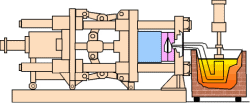Die Casting Processes. Die casting has a similarity to permanent mold casting. The exception is metal is injected into the mold or die casting mold under the high pressure which results to a good surface finish and accurate dimension. Die casting can use cold chamber or hot chamber process.
In a cold chamber process, molten metal is gradually transferred into the cold chamber for every shot. This is useful especially for metals like Aluminum, Copper and its alloys. There is less time exposure of melt to the plunger.
In a hot chamber process, the pressure chamber is connected to the die cavity. It is permanently immersed in the molten metal. Pressurizing cylinder inlet port is uncovered as plunger moves to open portion, which allows molten metal into the cavity. This hot chamber is useful for metals of low melting point and high fluidity. Examples are Zinc, Tin and lead that does not alloy easily with the steel.
Die casting molds have a tendency to be expensive because they are produced from hardened steel and has a long cycle time to build. Also, iron and steel are very strong and hard metals and therefore cannot be die cast.
Zinc has high melt fluidity and can therefore be made to close tolerances and with thinner walls than Aluminum. It is alloyed with Aluminum and this makes it hard and strong. Casting is at fairly low temperature (425ºC). Zinc alloys are used to manufacture precision parts like connector housings, sprockets, gears, etc. Copper alloys are useful in electrical, marine and plumbing. They are corrosion and wear resistant.

American Die Casting Company.
Die Casting Zinc Company specializes also in Zinc lighting Castings.
Look at this webpage for
zinc cast part prices. Email us at Sales@DieCastingZinc.com


